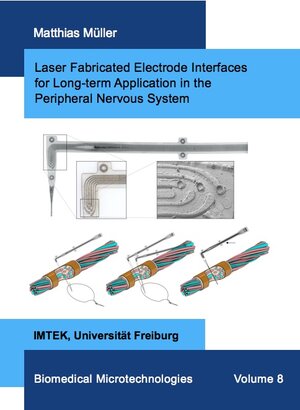
×
![Buchcover ISBN 9783843934916]()
Laser Fabricated Electrode Interfaces for Long-term Application in the Peripheral Nervous System
von Matthias MüllerImplantable electrode arrays often consist of materials that are not suitable for chronic studies with human patients. Therefore, a transfer into medical devices is associated with high costs and time expenditure. The thesis describes the development of a novel intrafascicular electrode array based on Parylene C, a polymer with USP class VI certification, and its application in vivo.
For this purpose, a rapid prototyping process was established with the aid of an ultrashort pulse laser system, achieving feature sizes comparable to the litho-graphically produced polyimide-based counterpart. Parylene C was tested for its in vitro long-term stability as well as its in vivo biocompatibility. Excellent stability and biocompatibility, comparable to polyimide as substrate material, confirmed the choice.
The newly developed manufacturing process allowed the local manipulation of the adhesion between Parylene C and platinum/iridium foil without the use of chemical adhesion promoters. The process also allowed the production of intrafascicular electrode arrays with electrode openings on the front and rear side. Due to the intrinsic rapid development and manufacturing cycles, the electrode design could be optimized utilizing design of experiment, with regard to mechanical stability. The functionality and biocompatibility of the new electrode arrays was then successfully tested for up to three months in vivo.
The stability of the electrodes was evaluated by accelerated aging with regard to their electrical insulation between adjacent channels. On the basis of electrochemical measurements differently processed electrode surfaces were characterized and evaluated. A novel surface structure integrated into the laser process led to an increase of the active surface area by a factor of 4.5, as compared to an unstructured platinum/iridium surface. This corresponds to an increase in the maximum injectable charge per stimulation pulse from 60 μC/cm² to 272 μC/cm² with unchanged biostability and biocompatibility.
For this purpose, a rapid prototyping process was established with the aid of an ultrashort pulse laser system, achieving feature sizes comparable to the litho-graphically produced polyimide-based counterpart. Parylene C was tested for its in vitro long-term stability as well as its in vivo biocompatibility. Excellent stability and biocompatibility, comparable to polyimide as substrate material, confirmed the choice.
The newly developed manufacturing process allowed the local manipulation of the adhesion between Parylene C and platinum/iridium foil without the use of chemical adhesion promoters. The process also allowed the production of intrafascicular electrode arrays with electrode openings on the front and rear side. Due to the intrinsic rapid development and manufacturing cycles, the electrode design could be optimized utilizing design of experiment, with regard to mechanical stability. The functionality and biocompatibility of the new electrode arrays was then successfully tested for up to three months in vivo.
The stability of the electrodes was evaluated by accelerated aging with regard to their electrical insulation between adjacent channels. On the basis of electrochemical measurements differently processed electrode surfaces were characterized and evaluated. A novel surface structure integrated into the laser process led to an increase of the active surface area by a factor of 4.5, as compared to an unstructured platinum/iridium surface. This corresponds to an increase in the maximum injectable charge per stimulation pulse from 60 μC/cm² to 272 μC/cm² with unchanged biostability and biocompatibility.


